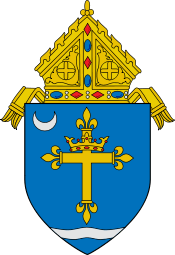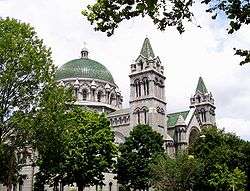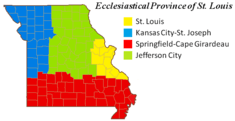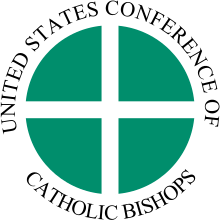Roman Catholic Archdiocese of St. Louis
| Archdiocese of Saint Louis Archidioecesis Sancti Ludovici | |
|---|---|
 | |
| Location | |
| Country | United States |
| Territory | Greater St. Louis and ten counties in eastern Missouri |
| Ecclesiastical province | St. Louis |
| Statistics | |
| Area | 5,968 sq mi (15,460 km2) |
| Population - Total - Catholics |
(as of 2015) 2,231,663 516,654 (23.1%) |
| Parishes | 184 |
| Schools | 112 |
| Information | |
| Denomination | Catholic |
| Rite | Roman Rite |
| Established | July 18, 1826 (192 years ago) |
| Cathedral | Cathedral Basilica of St. Louis |
| Co-cathedral | Basilica of St. Louis, King |
| Patron saint |
Saint Louis IX Saint Vincent DePaul Saint Rose Philippine Duchesne |
| Secular priests | 337 |
| Current leadership | |
| Pope | Francis |
| Archbishop | Robert James Carlson |
| Auxiliary Bishops | Mark Steven Rivituso |
| Emeritus Bishops | Robert Joseph Hermann |
| Map | |
.jpg) | |
| Website | |
| www.archstl.org | |

The Archdiocese of St. Louis (Latin: Archidioecesis Sancti Ludovici) is the Roman Catholic archdiocese that covers the City of St. Louis and the Missouri counties of Franklin, Jefferson, Lincoln, Perry, Saint Charles, Saint Francois, Ste. Genevieve, St. Louis, Warren, and Washington. It is the metropolitan see to the suffragan sees of the Diocese of Springfield-Cape Girardeau, the Diocese of Jefferson City, and the Diocese of Kansas City-Saint Joseph.
It is currently led by Robert James Carlson, the former Bishop of Saginaw, who was named the Archbishop-elect on April 21, 2009, by Pope Benedict XVI, and was installed on June 10, 2009.[1] Archbishop Carlson was assisted by Auxiliary Bishop Emeritus Robert Joseph Hermann who is now retired. His current auxiliary bishop is Mark Steven Rivituso who was appointed in 2017 and who replaced Auxiliary Bishop Edward Matthew Rice who served from 2010 to 2016 after replacing Hermann. His predecessor was Archbishop Raymond Burke until Burke's transfer to the position of Prefect of the Supreme Tribunal of the Apostolic Signatura on June 27, 2008. The archdiocesan cathedral is the Cathedral Basilica of St. Louis. The original cathedral and mother church is the Basilica of St. Louis, King of France. The Archdiocese is also one of two in the world that has both an Archbishop and a Cardinal, as Cardinal Raymond Burke's See remains St. Louis, and represents the Archdiocese in the College of Cardinals.
History
The first parish of Saint Louis was established in 1770 and it was incorporated into the Diocese of Louisiana and the Two Floridas when it was erected on April 25, 1793. The diocese originally encompassed the entire Louisiana Purchase, from the Gulf of Mexico to British North America, as well as the Florida peninsula and the Gulf Coast. The date of its establishment makes it the second-oldest diocese in the present-day United States: the Diocese of Baltimore was established on November 6, 1789. At the time of its establishment, the territory of the Diocese of Louisiana and the Two Floridas was part of the Archdiocese of San Cristobal de la Habana, based in Havana, Cuba. The diocese was divided into smaller dioceses several times, and many modern dioceses in the central United States were originally part of the Diocese of Louisiana and the Two Floridas. The city of Saint Louis was sold to the United States in 1803. The area's first bishop was Louis William Valentine Dubourg, who on September 24, 1815, was appointed Bishop of Louisiana and the [East and West] Two Floridas by Pope Pius VII. He was the Bishop of the Louisiana Territory from 1815-1826.[2] Unlike his predecessor, who set up his see in New Orleans, DuBourg chose to set up his episcopal see in St. Louis. After his resignation and transfer to lead the diocese of Montauban, France, the diocese of Louisiana was split, giving New Orleans a bishop again, and the Diocese of St. Louis was erected on July 18, 1826, by Pope Leo XII. When founded, it included the state of Missouri, the western half of Illinois, and all American territory west of the Mississippi River and north of the state of Louisiana. It was the largest American diocese, equaling in extent all of the other nine dioceses.
Its first bishop, Joseph Rosati, led the Roman Catholic Church's expansion of its presence in these areas, and built its first cathedral, now known as the Basilica of St. Louis, King of France. He was the Bishop of St. Louis from 1826-1843.[2]
On July 28, 1837, territory in Iowa, Minnesota, and the Dakotas was taken from the Diocese to form the Diocese of Dubuque, Iowa.
Until 1840, the "Old Cathedral" was the only church in the city. By 1850, there were 10: Cathedral of St. Louis, St. Mary of Victories, St. Francis Xavier, St. Patrick, St. Joseph, St. Vincent de Paul, St. John the Apostle, Sts. Peter and Paul, Holy Trinity, and St. Michael.[2]
The St. Louis Diocese was elevated to an Archdiocese on July 20, 1847, by Pope Pius IX.
Because of its strong Catholic identity and having been the mother diocese of many dioceses in the midwest, the archdiocese was often referred to as "the Rome of the west". It is dedicated to Saint Louis IX and has as its copatrons Saints Vincent de Paul and Rose Philippine Duchesne. St. Louis IX, the patron of the archdiocese, represents the ideal Christian knight- a fervent layman, a man of honor and a leader unafraid of exhibiting his ardent spirituality. In 1833 a French laymen answered what the Second Vatican Council calls the universal call to holiness of all Christians. Blessed Frederic Ozanam founded the St. Vincent de Paul Society to serve the poor. The first chapter of the Society in the United States was started in St. Louis in 1845, led by Judge Bryan Mullanphy who later became mayor of the city of St. Louis. Mother Rose Philippine Duchesne and the Religious of the Sacred Heart opened the first school for girls west of the Mississippi, in St. Charles in 1818.
The Cathedral Basilica of Saint Louis contains the largest collection of mosaics in the world and is one of St. Louis' most impressive architectural treasures. The Cathedral of St. Louis was dedicated in 1926 on the 100th anniversary of the establishment of St. Louis as a diocese. An imposing structure – solid, permanent, huge – the building's richly colored interior mosaics are a visual prayer. Built under the direction of Archbishop John Glennon – the last Irish-born Bishop of St. Louis – and completed under the leadership of Archbishop John May, every impressive inch of the Cathedral is used to tell the story of salvation and the history of the Catholic faith lived in St. Louis. Work on the Cathedral mosaics would not be completed for 60 years. The Cathedral of St. Louis was designated a "Basilica" in 1997 on the 150th anniversary of the archdiocese.[2]
St. Louis Preparatory Seminary in the countryside which is now the St. Louis suburb of Shrewsbury was completed in 1931. Later it became Cardinal Glennon College and in 2015 it is home to 125+ from St. Louis and other dioceses all over the world. Today it is called Kenrick-Glennon Seminary.
In January 1999, the archdiocese was host to a two-day visit from Pope John Paul II, the first time a pope had visited the city. It was not John Paul's first visit, since 30 years earlier, he had paid a visit when he was Cardinal Wojtyła, Archbishop of Kraków.
Bishops
The following is a list of the bishops and archbishops of St. Louis, and coadjutors and auxiliary bishops of St. Louis; and their years of service.
Bishop of Louisiana and the Floridas
- Louis-Guillaume-Valentin Dubourg, (1812-1826), appointed Bishop of Montauban and later Archbishop of Besançon
Bishop of St. Louis
- Joseph Rosati, C.M. (1827-1843)
- Peter Richard Kenrick (1843-1847)
Archbishops of St. Louis
- Peter Richard Kenrick (1847-1895)
- John Joseph Kain (1895-1903)
- Cardinal John J. Glennon (1903-1946)
- Cardinal Joseph Ritter (1946-1967)
- Cardinal John Joseph Carberry (1968-1979)
- John L. May (1980-1992)
- Justin Francis Rigali (1994-2003), appointed Archbishop of Philadelphia (elevated to Cardinal in 2003)
- Raymond Leo Burke (2004-2008), appointed Prefect of the Apostolic Signatura and later Patron of the Order of Malta (elevated to Cardinal in 2010)
- Robert J. Carlson (2009-present)
Coadjutor Bishops
- John Timon, C.M. (1839), appointed Prefect Apostolic of the Republic of Texas and later Bishop of Buffalo
- James Duggan (1857-1859), appointed Bishop of Chicago
- Patrick John Ryan (1872-1884), appointed Archbishop of Philadelphia
Auxiliary Bishops
- Christian Herman Winkelmann (1933–1939), appointed Bishop of Wichita
- George Joseph Donnelly (1940–1946), appointed Bishop of Leavenworth
- John Patrick Cody (1947–1954), appointed Coadjutor Bishop and Bishop of Kansas City-Saint Joseph and later Coadjutor Archbishop and Archbishop of New Orleans and Archbishop of Chicago (elevated to Cardinal in 1967)
- Charles Herman Helmsing (1949–1956), appointed Bishop of Kansas City-Saint Joseph
- Leo Christopher Byrne (1954–1961), appointed Coadjutor Bishop and Bishop of Wichita and later Coadjutor Archbishop of St. Paul and Minneapolis
- Glennon Patrick Flavin (1957–1967), appointed Bishop of Lincoln
- George Joseph Gottwald (1961–1988)
- Joseph Alphonse McNicholas (1969–1975), appointed Bishop of Springfield in Illinois
- Charles Roman Koester (1971–1991)
- Edward Thomas O'Meara (1972–1979), appointed Archbishop of Indianapolis
- John Nicholas Wurm (1976–1981), appointed Bishop of Belleville
- Edward Joseph O'Donnell (1983–1994), appointed Bishop of Lafayette
- James Terry Steib (1983–1993), appointed Bishop of Memphis
- Paul Albert Zipfel (1989–1996), appointed Bishop of Bismarck
- Edward Kenneth Braxton (1995–2001), appointed Bishop of Lake Charles and later Bishop of Belleville
- Michael John Sheridan (1997–2001), appointed Bishop of Colorado Springs
- Joseph Fred Naumann (1997–2004), appointed Archbishop of Kansas City in Kansas
- Timothy Michael Dolan (2001–2002), appointed Archbishop of Milwaukee and later Archbishop of New York (elevated to Cardinal in 2010)
- Robert Joseph Hermann (2002–2010)
- Edward Matthew Rice (2010–2016), appointed Bishop of Springfield-Cape Girardeau
- Mark Steven Rivituso (2017-present)
Other priests of this diocese who became bishops
- Michael Portier, appointed Vicar Apostolic of Alabama and the Floridas and later Bishop of Mobile
- Patrick A. Feehan, appointed Bishop of Nashville and later Bishop and Archbishop of Chicago
- John Hennessy, appointed Bishop and later Archbishop of Dubuque
- John Joseph Hogan, appointed Bishop of Saint Joseph and later Bishop of Kansas City
- Joseph Melcher, appointed Bishop of Green Bay
- John Henry Tihen, appointed Bishop of Lincoln and later Bishop of Denver
- Christopher Edward Byrne, appointed Bishop of Galveston
- Mark Kenny Carroll, appointed Bishop of Wichita
- Marion Francis Forst, appointed Bishop of Dodge City and later Auxiliary Bishop of Kansas City in Kansas
- Luis Morgan Casey, appointed Auxiliary Bishop of La Paz and later Apostolic Vicar of Pando
- John Joseph Leibrecht, appointed Bishop of Springfield-Cape Girardeau
- John R. Gaydos, appointed Bishop of Jefferson City
- George Joseph Lucas, appointed Bishop of Springfield in Illinois and later Archbishop of Omaha
- Robert William Finn, appointed Coadjutor Bishop and later Bishop of Kansas City-Saint Joseph
- Richard Frank Stika, appointed Bishop of Knoxville
Eastern Rites
There are two Eastern Rite churches and one Eastern Rite Cathedral within the archdiocese's boundaries:
- St. Raymond's Cathedral, Eparchy of Our Lady of Lebanon of Los Angeles (Maronite)
- St. Louis Byzantine, Eparchy of Parma (Ruthenian)
- St. Mary's Assumption, Eparchy of Saint Nicolas of Chicago (Ukrainian)
Schools
There are 12 Archdiocesan and 15 private Catholic high schools:
- Barat Academy, Chesterfield
- Bishop DuBourg High School, St. Louis †
- Cardinal Ritter College Prep High School, St. Louis
- Chaminade College Preparatory School, Creve Coeur
- Christian Brothers College High School, Town & Country
- Cor Jesu Academy, Crestwood
- De Smet Jesuit High School, Creve Coeur
- Duchesne High School, St. Charles
- Incarnate Word Academy, Bel-Nor
- John F. Kennedy Catholic High School, Manchester † * closed 2017 *
- Nerinx Hall High School, Webster Groves
- Notre Dame High School, St. Louis
- Rosati-Kain High School, St. Louis †
- St. Dominic High School, O'Fallon
- St. Elizabeth Academy, St. Louis * closed 2013 *
- St. Francis Borgia Regional High School, Washington
- St. John Vianney High School, Kirkwood
- St. Joseph's Academy, Frontenac
- Saint Louis Priory School, Town & Country
- St. Louis University High School, St. Louis
- St. Mary's High School, St. Louis †
- St. Pius X High School, Festus †
- St. Vincent High School, Perryville
- Trinity Catholic High School, North County †
- Ursuline Academy, Oakland
- Valle Catholic High School, Sainte Genevieve
- Villa Duchesne and Oak Hill School, St. Louis
- Visitation Academy of St. Louis, Town and Country
†Archdiocesan high schools that are owned and operated by the Archdiocese.[4]
Cemeteries
The Archdiocese Office of Catholic Cemeteries operates 17 cemeteries in the region, including:[5]
- Resurrection
- Sts. Peter & Paul
- Mt. Olive
- Calvary
- Sacred Heart
- St. Charles Borromeo
- St. Peter
- St. Ferdinand
- St. Monica
- Our Lady
- Holy Cross
- St. Vincent
- Ste. Philippine
- St. Mary's
- Ascension
- Glencoe
- Queen of Peace
Suffragan sees

See also
- Catholic Church by country
- Catholic Church in the United States
- Ecclesiastical Province of Saint Louis
- Global organisation of the Catholic Church
- List of Roman Catholic archdioceses (by country and continent)
- List of Roman Catholic dioceses (alphabetical) (including archdioceses)
- List of Roman Catholic dioceses (structured view) (including archdioceses)
- List of the Catholic dioceses of the United States
References
- ↑ Tim Townsend, "Carlson installed as new leader of St. Louis Roman Catholics." St. Louis Post Dispatch, Jun. 11, 2009.
- 1 2 3 4 [Dolan, Timothy Michael. Archdiocese of St. Louis: Three Centuries of Catholicism, 1700-2000. Strasbourg, France: Editions Du Signe, 2001. Print.]
- ↑ The Official Catholic Directory. New York: P.J. Kenedy & Sons. 2015. pp. 1195, 1205–1206.
- ↑ Catholic Education
- ↑ Archdiocese of St. Louis: Cemeteries
External links
- Roman Catholic Archdiocese of St. Louis Official Site
- Archives section
- Story of John Paul II's 1999 visit
- St. Louis Review, the weekly newspaper of the archdiocese
- Rome of the West, features photography of churches in the Archdiocese
- Eastern rites in the Archdiocese:
Coordinates: 38°38′34″N 90°15′26″W / 38.64278°N 90.25722°W
